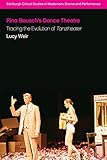Pina Bausch's Dance Theatre : Tracing the Evolution of Tanztheater / Lucy Weir.
Material type: TextSeries: Edinburgh Critical Studies in Modernism, Drama and Performance : ECSMDPPublisher: Edinburgh : Edinburgh University Press, [2022]Copyright date: ©2018Description: 1 online resource (224 p.) : 17 B/W illustrationsContent type:
TextSeries: Edinburgh Critical Studies in Modernism, Drama and Performance : ECSMDPPublisher: Edinburgh : Edinburgh University Press, [2022]Copyright date: ©2018Description: 1 online resource (224 p.) : 17 B/W illustrationsContent type: - 9781474436854
- GV1786.T33 W45 2018
- GV1786.T33 W45 2018
- online - DeGruyter
| Item type | Current library | Call number | URL | Status | Notes | Barcode | |
|---|---|---|---|---|---|---|---|
 eBook
eBook
|
Biblioteca "Angelicum" Pont. Univ. S.Tommaso d'Aquino Nuvola online | online - DeGruyter (Browse shelf(Opens below)) | Online access | Not for loan (Accesso limitato) | Accesso per gli utenti autorizzati / Access for authorized users | (dgr)9781474436854 |
Frontmatter -- CONTENTS -- List of Illustrations -- List of Choreographies -- Acknowledgements -- Introduction -- 1. A Bilingual Dancer -- 2. New Beginnings: The Origins of Bausch’s Tanztheater -- 3. Unmasked, Unfinished, Unresolved: A Dance Theatre of the Absurd -- 4. Violent Acts: Traversing the Postwar Landscape -- 5. Transient Tanztheater: The Co-Production Model -- 6. ‘I Only Tried To Speak About Us’ -- Concluding Thoughts -- Bibliography -- Index
restricted access online access with authorization star
http://purl.org/coar/access_right/c_16ec
First full-scale thematic analysis of Pina Bausch’s Tanztheater, critically evaluating the impact of modernist theatre on her choreographic methodThis book presents a new reading of Pina Bausch’s dance theatre, orienting it within an international legacy of performance practice. The discussion considers not only the influence of German and American modern dance on Bausch’s work but, crucially, interrogates parallels with modernist and postdramatic theatre (including Antonin Artaud, Samuel Beckett, Jerzy Grotowski, and Robert Wilson), the influence of which has been largely neglected in existing studies of her oeuvre.Pina Bausch’s Dance Theatre provides a wide-ranging study of Bausch’s aesthetic and methods of practice, with case studies ranging from the beginning of her career to her final choreographies.Key FeaturesThe first full-scale study interrogating the relationship between Bausch’s Tanztheater and modernist theatre practice, structured around a chronological framework of case study choreographiesA new theorisation of the development of Bausch’s oeuvre, locating her approach in a broader context of intercultural artistic exchange in the post-WWII periodDraws on literary and theatre theory to form an interdisciplinary methodology for understanding and interrogating Bausch’s oeuvreBased on extensive archival research and a specialised knowledge of the evolution of modern dance
Mode of access: Internet via World Wide Web.
In English.
Description based on online resource; title from PDF title page (publisher's Web site, viewed 29. Jun 2022)


